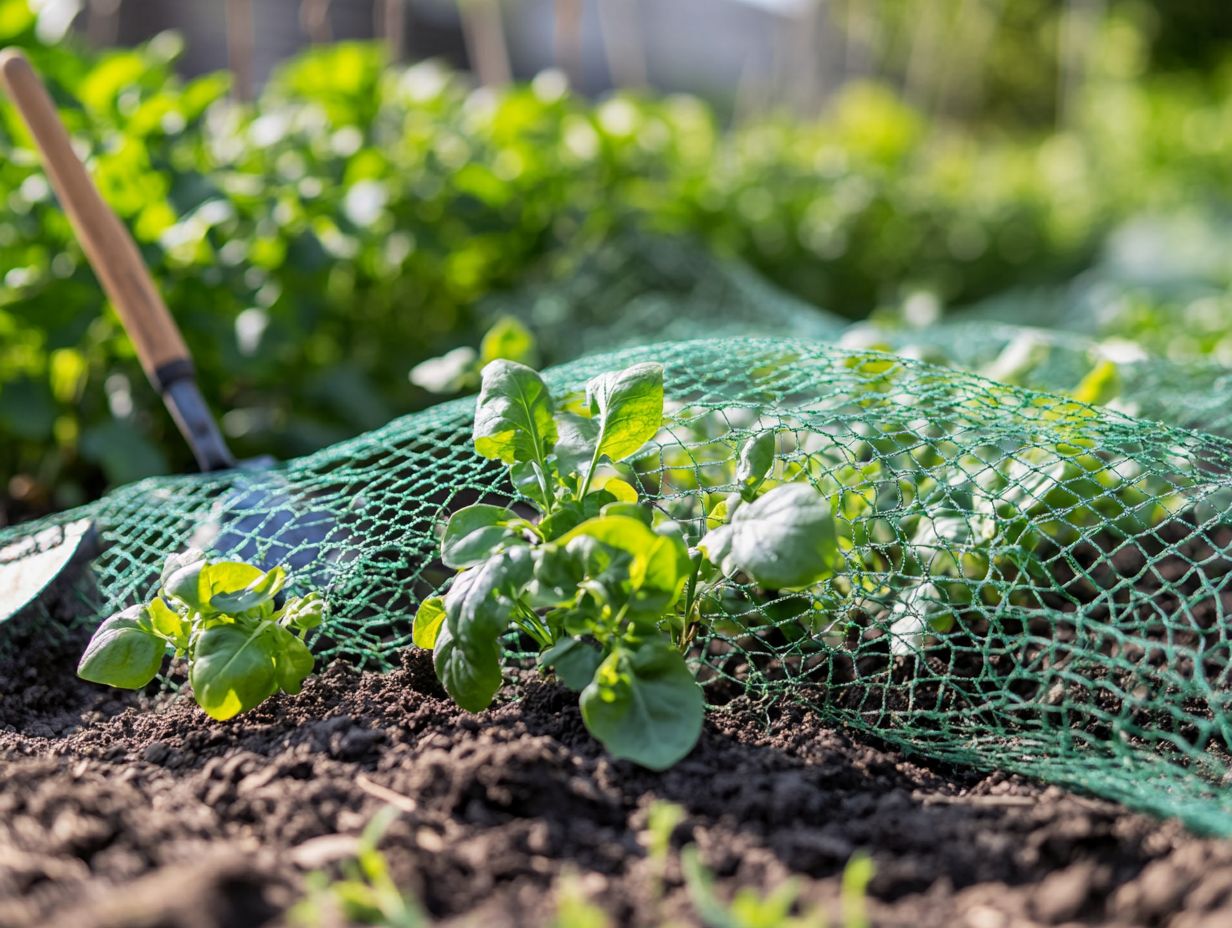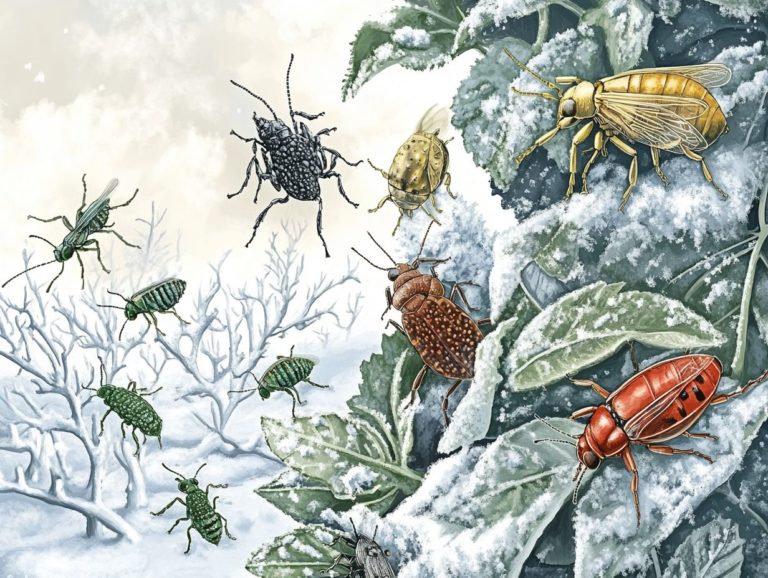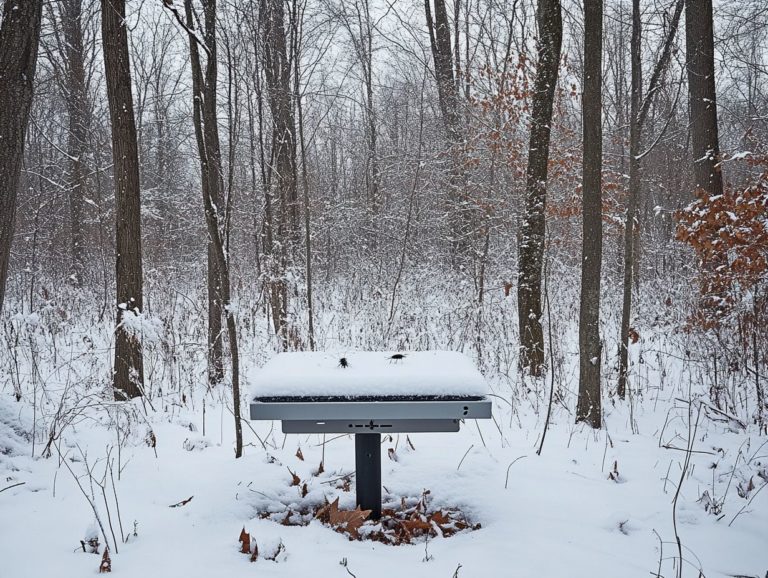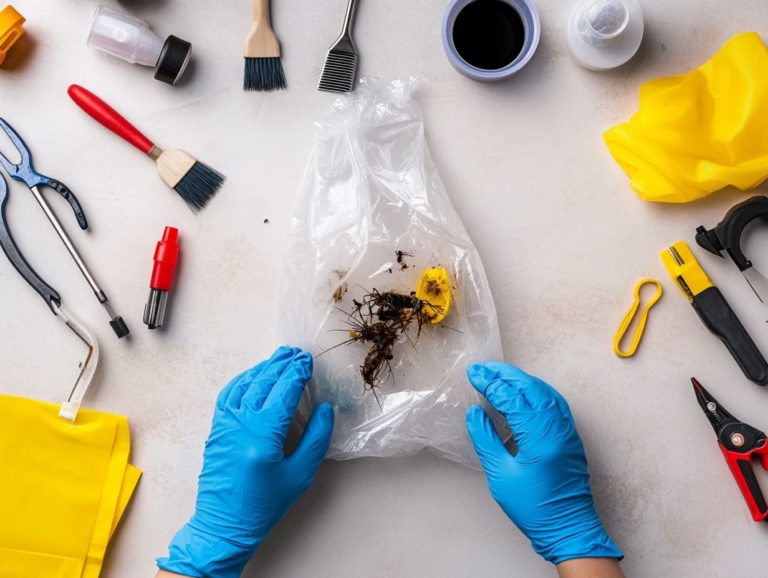5 Tips for Protecting Seedlings from Pests
Starting a garden is an exciting journey! However, protecting your cherished seedlings from pesky pests can be quite a challenge.
This article shares five essential tips to help you safeguard your young plants. You’ll discover strategies to keep your garden thriving, from choosing strong seedlings to using physical barriers.
Regular inspections are crucial. We will guide you on how often to check for unwanted visitors.
Embrace this journey to ensure your gardening efforts flourish!
Contents
- Key Takeaways:
- 1. Start with Healthy Seedlings
- 2. Use Physical Barriers
- 3. Implement Companion Planting
- 4. Use Natural Pest Control Methods
- 5. Regularly Inspect and Remove Pests
- What Are the Most Common Pests for Seedlings?
- Key Pests to Watch For
- How Can Physical Barriers Be Used to Protect Seedlings?
- What Are the Benefits of Companion Planting for Pest Control?
- What Are Some Effective Natural Pest Control Methods?
- How Often Should Seedlings Be Inspected for Pests?
- Are There Any Natural Predators That Can Help with Pest Control?
- Frequently Asked Questions
- What are the best ways to protect seedlings from pests?
- How can I prevent pests from damaging my seedlings?
- Are there any natural pest control methods I can use?
- What should I do if I find pests on my seedlings?
- Are there any preventative measures I should take to protect my seedlings?
- Can I use chemical pesticides to protect my seedlings?
Key Takeaways:

- Start with healthy seedlings to reduce vulnerability to pests.
- Use physical barriers like netting or row covers to block pests.
- Implement companion planting with pest-repelling plants for natural pest control.
1. Start with Healthy Seedlings
Starting with healthy seedlings is key. Strong seedlings are more resilient to pests, diseases, and other threats.
Selecting high-quality seedlings is just the beginning. Soil health, proper watering, and suitable fertilizers are also crucial.
You can enhance soil quality by practicing crop rotation, which prevents soil depletion and keeps pests at bay.
Incorporating organic matter like compost increases soil fertility, promotes strong root systems, and improves water retention.
When combined, these elements create a vibrant garden full of life and resilience.
2. Use Physical Barriers
Physical barriers are an effective way to protect your seedlings from pests and diseases. These obstacles significantly reduce the risk of infestations.
One popular method is using row covers. They allow sunlight and moisture in while keeping unwanted insects out.
Fine mesh nets can shield against flying pests and provide a breathable environment. Fencing can deter larger animals from invading your garden.
Alongside these barriers, keeping your landscape clean is vital. Regularly removing debris and weeds reduces hiding spots for pests.
3. Implement Companion Planting
Companion planting is a clever strategy where you pair compatible plants, like garlic and rosemary, to boost growth and deter pests.
By adding garlic and rosemary to your garden, you enhance natural pest control. Garlic repels pests like aphids, while rosemary wards off moths and flies.
This planting technique not only keeps harmful insects away but also supports a balanced ecosystem, nurturing a thriving gardening environment.
4. Use Natural Pest Control Methods

Employing natural pest control methods offers a sustainable solution for managing pest infestations while safeguarding the environment. This approach includes utilizing organic pesticides, such as neem oil, and encouraging good bugs that help control pests within your garden ecosystem.
Incorporating techniques like essential oils that repel unwanted insects can significantly enhance your garden’s health. Creating homemade sprays from everyday household ingredients allows you to cultivate a healthier growing space and explore the use of natural insecticides.
By introducing allies like ladybugs and lacewings, you can significantly enhance the control of aphid populations. This helps maintain a delicate balance within pest dynamics.
This strategy helps eliminate pests and fosters the overall vitality of your plants, enabling them to thrive without the detrimental effects of synthetic chemicals.
Start using these practices today to create a vibrant ecosystem where your plants and good bugs thrive together!
5. Regularly Inspect and Remove Pests
Regular inspections and timely removal of pests are essential practices in pest control to help protect your crops and indoor plants. They enable you to quickly identify invasive pests and manage outbreaks before they escalate into serious threats to your precious seedlings and plants.
Effective pest management starts with understanding when to inspect typically during the early mornings or late evenings when temperatures are cooler. Pests, such as aphids and beetles, are most active during these times.
During these checks, be sure to thoroughly examine the undersides of leaves and stems for any signs of infestation. Look for tiny holes, discolored patches, or the sticky residue left behind by sap-sucking pests.
Fungal infections might show up as unusual spots or a powdery coating. If not addressed, these can lead to serious diseases affecting your plants. Recognizing these symptoms early is crucial, as acting promptly can significantly enhance your chances of preserving plant health.
This allows you to implement necessary measures, such as targeted treatments or adjustments to your care routine, ensuring your garden thrives.
What Are the Most Common Pests for Seedlings?
Do you know which pests are the biggest threats to your seedlings? Understanding the most common pests threatening your seedlings and tropical plants is essential for effective pest management. Early identification allows you to implement proactive measures that safeguard your precious plants from harmful infestations and diseases.
Key Pests to Watch For
Among these notorious intruders, you ll find aphids tiny sap-sucking insects that can multiply at an alarming rate and wreak havoc on your plants and entire garden. They drain vital nutrients from your young plants, leading to stunted growth.
Then there are caterpillars, the larval stage of various moths and butterflies. They can decimate your leafy greens in mere days as they voraciously chew through the foliage.
Don t overlook beetles, either. The infamous Japanese beetle and the striped cucumber beetle are known for wreaking havoc, feeding on both leaves and stems, leaving behind unmistakable holes.
The signs of their presence can vary: aphid infestations often result in curled leaves and a sticky residue known as honeydew. Caterpillars leave behind their characteristic frass, or droppings.
By understanding these pests and recognizing the damage they can inflict, you can play a pivotal role in preserving the health of your developing seedlings and ensuring your garden thrives.
Stay vigilant and act quickly to protect your garden from these pests!
How Can Physical Barriers Be Used to Protect Seedlings?
Protect your seedlings with physical barriers! These excellent measures shield your plants from harmful pests and diseases, minimizing the risk of pest problems while still allowing plenty of sunlight and moisture to reach them. For more information, check out these 5 tips for winter seed starting indoors.
Barriers can take various forms in your garden, such as mesh screens, row covers, and cloches. Each option meets specific needs while keeping your landscape clean and free from debris. For example, mesh keeps out larger insects like cabbage moths without hindering air circulation. Row covers trap warmth, protecting your young greens from both pests and frost. Meanwhile, cloches provide localized protection, shielding delicate flowers and encouraging earlier growth in cooler temperatures.
Thoughtfully implementing these barriers can significantly enhance the health of your garden and help prevent pest problems. Just remember: maintaining a clean landscape, free from debris and decaying matter, is equally crucial for their effectiveness!
What Are the Benefits of Companion Planting for Pest Control?

Discover the wealth of benefits that companion planting offers for pest control! This technique allows you to pair specific plants to enhance their natural ability to repel pests while attracting beneficial insects that bolster plant health.
For example, when you plant garlic among your roses, its strong aroma acts as a barrier against aphids and other pests, effectively protecting those delicate flowers. Similarly, positioning rosemary alongside cabbage and broccoli serves as a protective guardian herb, deterring cabbage moths and promoting robust growth in these vegetables.
This harmonious relationship reduces your dependence on chemical pesticides and fosters a healthier ecosystem. Embracing such techniques highlights the significance of biodiversity the variety of plants and animals in your garden which leads to a more resilient and productive growing system.
What Are Some Effective Natural Pest Control Methods?
You can explore several effective natural pest control methods to manage pests while minimizing environmental impact. For instance, consider using organic pesticides like neem oil and fostering a habitat for beneficial insects in your garden!
Introducing ladybugs and lacewings can significantly reduce aphid populations, offering an eco-friendly solution. You can also practice crop rotation and companion planting. These methods not only deter unwanted pests but also enhance soil health and biodiversity.
Embrace a multi-faceted approach to pest management! It’s not merely about removing pests; it s about nurturing a balanced ecosystem that supports beneficial organisms.
By integrating these methods, you can cultivate a sustainable environment that enhances plant health and resilience against potential infestations.
How Often Should Seedlings Be Inspected for Pests?
Inspect your seedlings weekly! Regular inspections are essential for effective pest management. Aim to conduct these evaluations at least once a week to catch any signs of pest infestations or diseases that could jeopardize your plants’ health.
Frequent assessments provide early protection, enabling you to address issues before they spiral out of control. Catching pests like aphids or spider mites early can dramatically minimize the risk of widespread damage.
During inspections, closely examine the undersides of leaves, stems, and the soil for any unusual discoloration, webbing, or visible insects. Evaluating the overall vigor and growth patterns of your seedlings gives you valuable insights into their nutritional needs and health, allowing you to implement effective pest control strategies that include organic matter and natural insecticides.
Are There Any Natural Predators That Can Help with Pest Control?
Incorporating natural predators into your gardening ecosystem is a powerful strategy for pest control. These beneficial insects help manage pest populations while contributing to the overall health and balance of your plants.
By attracting allies like ladybugs, lacewings, and wasps that lay their eggs inside pest larvae, you can create a harmonious environment where these predators thrive. Ladybugs, with their strong desire for aphids, effectively keep those pesky numbers in check. Lacewings target a variety of nuisances, including spider mites and thrips. Parasitic wasps take it a step further by providing a natural solution to infestations.
To cultivate a thriving habitat for these allies, incorporating native plants, maintaining diverse garden structures, and minimizing chemical use is key. This approach ensures a robust ecosystem that supports both your plants and their protective partners.
Frequently Asked Questions

What are the best ways to protect seedlings from pests?
- Use physical barriers such as row covers or netting to prevent pests from reaching your seedlings.
- Apply organic pest control methods, such as using beneficial insects or homemade sprays.
- Keep your garden clean and tidy to discourage pests from making their home near your seedlings.
- Try companion planting by pairing certain plants together to naturally repel pests.
- Rotate your crops each season to prevent pests from establishing themselves in the same area.
How can I prevent pests from damaging my seedlings?
- Inspect your seedlings regularly for signs of pest damage, such as holes in leaves or wilted stems.
- Remove any damaged or infested plants immediately to prevent the pests from spreading.
- Always use clean gardening tools and equipment to avoid introducing pests to your seedlings!
- Keep a close eye on the weather and water your seedlings appropriately to prevent stress that can attract pests.
- Choose pest-resistant plant varieties when starting your seedlings.
Are there any natural pest control methods I can use?
- Introduce beneficial insects such as ladybugs, lacewings, and praying mantises to your garden.
- Plant pest-repelling herbs like basil, mint, and garlic near your seedlings.
- Make homemade insecticidal sprays using ingredients like neem oil, soap, and hot peppers.
- Use physical barriers like copper tape or diatomaceous earth to deter pests.
- Utilize natural predators like birds or frogs by creating a welcoming habitat in your garden.
What should I do if I find pests on my seedlings?
- Identify the type of pest and research the best methods for controlling them.
- Remove the pests by hand if possible or use a targeted pest control method.
- Keep an eye on your seedlings to ensure the pests do not return.
- Consider using organic methods of pest control to avoid harm to beneficial insects or your seedlings.
- Take preventative measures to avoid future pest infestations.
Are there any preventative measures I should take to protect my seedlings?
- Avoid overwatering your seedlings, as it can attract pests and promote fungal growth.
- Harden off your seedlings before transplanting them into the garden to make them stronger and better able to withstand pests.
- Keep weeds under control as they can provide shelter and food for pests.
- Plant your seedlings in well-drained soil to prevent waterlogged conditions that can attract pests.
- Use floating row covers to protect your seedlings from both pests and harsh weather conditions.
Can I use chemical pesticides to protect my seedlings?
- Chemical pesticides should be a last resort, as they can harm beneficial insects and potentially your seedlings.
- If you do decide to use a chemical pesticide, make sure to follow the instructions carefully and use it in a targeted manner.
- Consider using organic pesticides instead, as they are less harmful to the environment.
- Always use caution when using any type of pesticide and wear protective gear.
- Regularly monitor your seedlings to ensure the pesticide is effective and no further action is needed.
Start implementing these pest control methods today to protect your seedlings!






